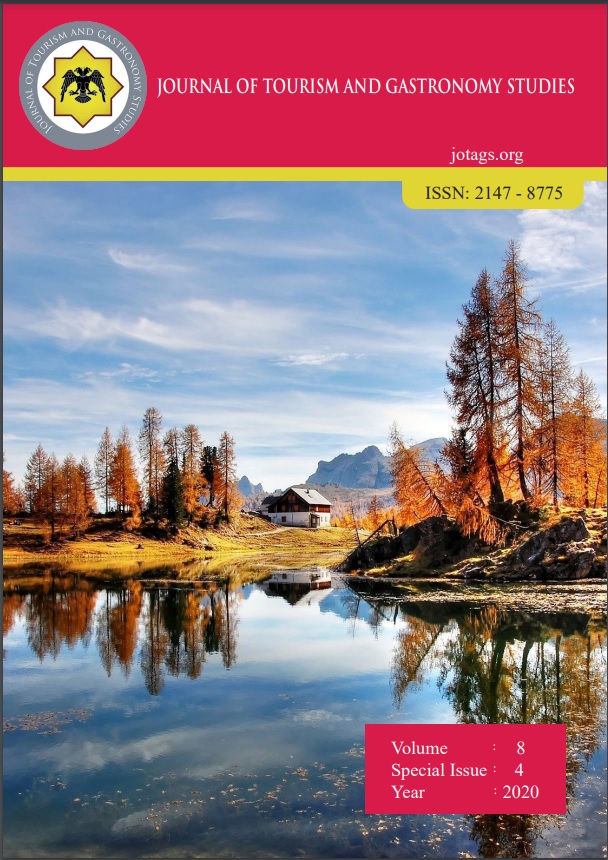Turizm Ekonomi Politikalarında Hesaplanabilir Genel Denge Modelinin Değerlendirilmesi (The Evaluation of the Computable General Equilibrium Model in Tourism Economy Policies)
DOI:
https://doi.org/10.21325/jotags.2020.684Keywords:
Equilibrium, CGE models, Foresight, AnalysisAbstract
In national and regional economic policy practices, since price and cost pressures in any industry arising from supply and demand relations have impact on other industries. Because of that the necessity of a balance of economic expansion or contraction has emerged. Recently, due to the weaknesses inherent in the Input-Output model, both in macro and micro economies, as a new paradigm shift "Computable General Equilibrium (CGE) Models" have been introduced. CGE models are consist of a series of equations that examine the production, consumption, trade and government activities of the country's economy. The purpose of this study is to evaluate the economic effects of changes in tourism revenues and expenditures and to make predictions based on real data, mathematically / statistically determined basic relationships in the policy making of CGE models against the shocks that may occur in tourism economies. This study reveals the advantages of the economic effects of the shocks that may arise in tourism demand compared to the input-output analysis of CGE models. In addition to examining CGE models, the effects of static and dynamic aspects on destination management stakeholders were characterized. In this study metodically, the contributions of the five main sectors of the economy, which are included in the structure of the CGE model, and their importance on tourism decision makers are emphasized. In the study qualitative patterned document technique was used. According to the findings obtained; Examples of the CGE models in selected countries are included. As a result of such modeling, the appropriateness of tourism analysis and policy to various fields of tourism has been revealed and unique approaches to tourism planning, predictions and decision making have been determined. As a result of this study, why by governments, public and private sector institutions, consultants, and researchers should pay more interest in tourism policy analysis has been explained.
References
Adams, P. D. & Parmenter, B. R. (1995). An Applied general equilibrium analysis of the economic effects of tourism in a quite small, quite open economy. Applied Economics , 27(10), 985–994.
Blake A.T., Sinclair, M.T. & Sugiyarto, G. (2003a). Quantifying the impact of foot and mouth disease on tourism and the UK economy. Tourism Economics, 9(4), 449–465.
Blake, A., J.S. Arbache, M.T. Sinclair & Teles, V. (2008). Tourism and poverty relief. Annals of Tourism Research, 35(1), 107–126.
Blake, A.T. & Sinclair, M.T. (2003) Tourism crisis management: US response to September 11. Annals of Tourism Research, 30(4), 813–832.
Blake, A., Durbarry, R., Eugenio-Martin, J. L., Gooroochurn, N., Hay, B., Lennon, J., Sugiyarto, G., Sinclair, M. T. & Yeoman, I. (2004). Tourism in Scotland: The Moffat Model for Forecasting and Policy in Complex Situations. Christel DeHaan Tourism and Travel Research Institute Discussion Paper, http://www.nottingham.ac.uk/ttri/series.html, 2004/2.
Blake, A.T. (2004). The Structure of the Moffat Scenario CGE Model, Christel DeHaan Tourism and Travel Research Institute Discussion Paper, http://www.nottingham.ac.uk/ ttri/series.html, 2004/6.
Dywer, L. (2015). Computable general equilibrium modelling: An important tool for tourism policy analysis. Tourism and Hospitality Management, 21(2).
Dwyer, L. Forsyth, P. & Dwyer, W. (2011). Tourism Economics and Policy. Aspects ofTourısm Texts Series Editors: Chris Cooper (Oxford Brookes University, UK), C. Michael Hall (University of Canterbury, New Zealand) and Dallen J. Timothy (Arizona State University, USA).
McDougall, R. (1995). Computable general equilibrium modelling: Introduction and overview, Asia-Pacific Economic Review, 1(1), 88–91.
Kozak M. & Bahar. O. (2018). Turizm Ekonomisi. 8. Baskı. Detay Yayıncılık.
Wattanakuljarus, A & Coxhead, I. (2008). Is tourism-based development good for the poor? A general equilibrium analysis for Thailand, Journal of Policy Modeling, 30(6), 929–955.
Dünya Turizm Örgütü (2015), Statistic and TSA, Issue paper series. Computable General Equilibrium Modelling for Tourism Policy Inputs and Outputs. 4. Structure of GCE Model. Figure.1
Wing, I. S. (2004), Computable General Equilibrium Models and their use in economy-wide policy. The MIT Joint Program on the Science and Policy of Global Change, Technical Note Number 6.
Downloads
Published
How to Cite
Issue
Section
License
Copyright (c) 2023 Journal of Tourism & Gastronomy Studies

This work is licensed under a Creative Commons Attribution-NonCommercial 4.0 International License.








